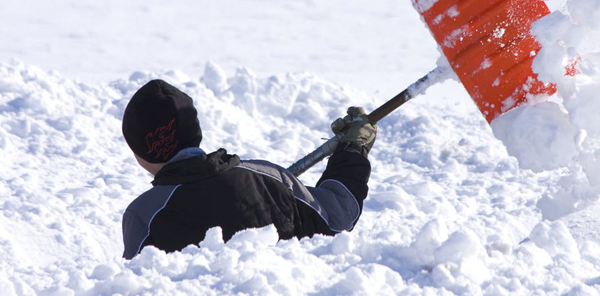Oh, the agony. And that’s just the thought of bending, lifting and displacing a foot of snow piled onto the driveway, one shovelful at a time.
A foot of snow is exactly what much of the state was looking at on Monday, Feb. 1. But rather than obsessing over the negatives, look at it as a workout and treat it like one, says the National Safety Council:
- Warm up for 10 minutes with light exercise and stretches.
- Don’t overdo it. Shoveling snow can push your heart rate and blood pressure higher, dramatically.
- Take frequent breaks.
- Drink plenty of fluids.
- Use a shovel suitable for your height and strength. If using a large shovel, fill it no more than halfway.
- Don’t lift the snow. Push it. If lifting, bend your knees and use your legs — don’t bend at the waist — to reduce strain on your back.
- Do not use a twisting motion to throw snow either to the side of over your should. It’s bad for your back.
- Do not shovel while smoking or after eating.
Health cautions:
- If you have a history of heart trouble, do not shovel snow without your doctor’s approval.
- Be extra careful if you’re over 40 years old. And the same for the resident couch potatoes.
- Don’t knock yourself out. If you run out of breath, pause.
- If you feel chest pain, stop immediately and call 9-1-1.
Using A Snow Blower
Never stick your hands in the snow blower. Common sense, right? A University of Arkansas researcher who studied more than 30,000 snow blower injuries four years ago found a common theme — many people were injured even with the machine powered down. They put a hand in a clogged chute, with some assurance because the snow blower wasn’t running, but when they removed some snow the rotational force of the suddenly freed blades injured the hand.
So:
- If snow jams the snow blower, stop the engine, and use a solid object to clear the chute.
- Never leave a running snow blower unattended
Never add fuel in an enclosed space. - Don’t wear a scarf or other loose clothing that might get caught in the snow blower’s moving parts.
- Use an electronic ignition when possible. Pulling a stuck pull-cord can injure your upper body or back.
- Don’t run the machine in an enclosed area such as a garage or shed. (Gasoline engines release carbon monoxide.)
Carbon Monoxide (CO) Poisoning:
Carbon monoxide is an odorless, colorless gas produced by winter household staples like portable generators, snow blowers and the fireplace, whether fueled by oil, natural gas or wood.
Some basics:
- Make sure the damper is open, ensuring proper ventilation, before using a fireplace.
- Never use a generator in the garage and especially in the home.
- Keep generators at least 20 feet from your home, doors and windows.
- Never heat your home with your oven or stovetop.
- Never use a barbecue grill in the garage.
- Install a CO detector, either battery operated or hardwired with a battery backup, in every sleeping area of your home. Change the batteries every year.
For the latest updates on the storm, and more snow health tips, visit www.hartfordhealthcare.org/storm


